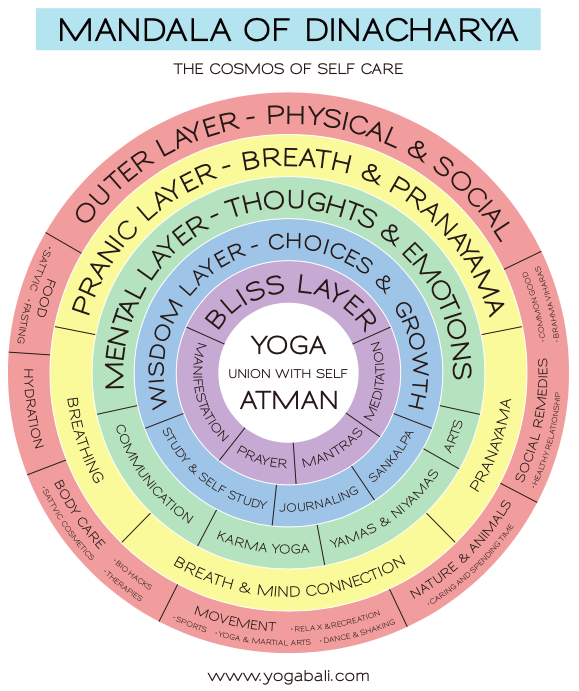The Mandala of Dinacharya
The Cosmos of Self-Care and the Essence of Self-Love
Self-care is more than a routine — it is a declaration of love for yourself.
In a world marked by constant change, as reflected in the astrological shift of Pluto in Aquarius in November 2024, maintaining inner stability and practicing regular self-care are vital. These practices equip us with the calm & strength to face challenges with resilience. Dinacharya, an ancient Ayurvedic concept rooted in daily routines, restores our connection to ourselves, others and nature, promoting holistic well-being.
What is Dinacharya?
Derived from Sanskrit, Dinacharya combines dina (day, sun, or river) and charya (practice, discipline, or attitude). It is an Ayurvedic approach to self-care, involving routines that align with the earth’s natural rhythms. These rituals harmonize the body, mind, and soul, fostering balance as per Ayurvedic principles.
At Yoga Bali, we merge the wisdom of ancient yoga with modern methods, calling this integration “The Mandala of Dinacharya.”
This model is based on the five koshas (layers of being), which encompass physical, mental, and spiritual aspects of our existence.
The Five Layers of the Mandala of Dinacharya
- The Outer Layer (Anamaya Kosha): Physical and Social
- The Energy Layer (Pranamaya Kosha): Life Energy and Breathwork
- The Mental/Emotional Layer (Manomaya Kosha): Thoughts and Emotions
- The Wisdom Layer (Vijnanamaya Kosha): Growth and Discernment
- The Ecstasy Layer (Anandamaya Kosha): Divine Connection and Bliss
1. The Outer Layer: Body & Environment (Anamaya Kosha)
This layer comprises our physical body and our connection to the material world. It is the foundation on which our entire existence rests. Everything affecting our body and outer wellbeing such as clothes, food, water, exercise, care, housing and environment.
Nutrition
- Sattvic diet:
A diet that is fresh, organic, unprocessed, and free from violence supports the body optimally. Sattva means purity, clarity, and harmony. By choosing sattvic foods, we not only promote our physical health but also a calm mind. - Practical tips:
- Eat and cook slowly, calmly, regularly and with love at ideal times
- ideal times are being aware of the season, geographic location (time zone), age, and time of day
- Listen to your body: What exactly does it really need when?
- Food breaks & fasting:
Pauses & fasting relieve the body and give it time to regenerate. There are many forms of fasting, such as intermittent fasting, juice fasting or Ayurvedic fasting. Choose the method that suits your lifestyle and body. - Food supplements/superfoods:
If necessary, nutritional supplements such as vitamins or minerals can be added according to individual needs. Have yourself tested regularly to determine exactly what your body needs (blood tests, kinesiology, bio-resonance)
Hydration
- Water is our elixir of life. It nourishes every cell and supports numerous functions in the body. We are 80% water.
- Morning ritual: Drink a large glass of water ( after waking up, tongue brushing oil pulling), e.g., with lemon, brin. oils, herbs …
- Daily requirement: 6–12 glasses of water, depending on activity level, climate, and physical needs
- Quality: Pay attention to the water quality. Filter your water if necessary or test it regularly
Body Care
- Natural products: Use products that are so pure you could theoretically eat them. Your skin is permeable, and anything you put on it will enter your body.
- Morning Rituals:
- Tongue cleansing and oil pulling in the morning
- Body brushing for better circulation and detoxification
- Evening Rituals:
- Aromatherapy
- Gua Sha or massages for relaxation and care
- bath (with magnesium salts, essential oils, herbs)
- Bio hacks: Sauna, ice baths, red light etc.
- Therapies: Rolfing, craniosacral therapy, osteopathy etc.
Movement
- Regular exercise keeps the body healthy and energy flowing.
- Yoga: Asanas not only strengthen the body but also harmonise the mind
- Sports: Whether running, dancing, swimming, or martial arts such as tai chi, find an activity that brings you joy
- Relaxation, Rest & Recreation – regular breaks and pauses are essential to recharge, doing nothing just being
Nature and Animals
-
- Exercise and spend as much times as possible in nature, such as barefoot walking, times sun bathing, forest walks/baths or swimming in natural bodies of water
- Nurture, care for and spend time with animals
Social Remedies
- Cultivate healthy relationships with family, friends, and acquaintances. Choose good, encouraging, and wise company: “You are the one you hang out with.” Let the giving and deceiving be equal.
- Act, think, and speak for the common good
- Brahma Viharas: Develop qualities of kindness, compassion, joy in the success of others, and equanimity.
2. The Energy Layer: Breathing & Prana (Pranamaya Kosha)
Our life energy, prana, is nourished by our breathing. This layer focuses on the conscious control and harmonisation of the breath.
Breathing Awareness
- Breath is the essence of life
- Observe your breath: Do you breathe shallowly or deeply? Fast or calmly?
- Be aware that breathing contains prana. Prana is the divine, vital life force that sustains and revitalises our being.
Connection Between Breathing and Mind
- Your mind is as relaxed as your breath and vice versa.
- Calm your breath, calm your mind. “The mind is the king of the five senses. The breath is the king of the mind.” BKS Iyengar
Pranayama Techniques
- Ujjayii 1-8: Calms and focuses the mind
- Brahmari (humming): Promotes deep relaxation and mindfulness
- Viloma – interrupted breathing
are some of Yoga Bali Favorites to name a few
3. The Mental/Emotional Layer: Thoughts and Emotions (Manomaya Kosha)
This layer represents our mind and emotions, often influenced by our environment, thoughts, and sensory impressions.
Communication
- Practise non-violent communication. Pay attention to what you say, how you say it, why and to whom.
- Allow yourself moments/days of silence (Mauna) to clear your thoughts and calm down.
- Writing: Use tools like morning pages—write down your thoughts, feelings, fears, resentments and ideas.
Yamas & Niyamas
- These are ethical and moral guidelines for harmonious inner and outer life, forming the foundation of Patanjali’s 8-limb path, the yogic roadmap to self-realisation
- They act as the basis of a healthy mind and balanced life with healthy interactions
Karma Yoga
- Engaging in selfless service brings joy & stability in mind/emotions and offers life a deeper sense of meaning
Art & Creativity
- Explore creative outlets such as eg painting, music or writing. These activities help in expressing and healing emotions.
4. The Wisdom Layer: Reflection & Decisions (Vijnanamaya Kosha)
This layer encourages growth, discernment and the power to make wise decisions opening the door to inner voice, intuition and eternity.
Self-Study (Svadhyaya)
- Regularly reflect on your values, goals, and challenges
- Study ancient texts or modern philosophies (books, podcasts) to expand your perspective
- Explore individual or group therapy, coaching, or mentoring to deepen self-awareness
Journaling
- Dive into your inner world through writing:
- Explore thoughts, values, passions, and dharma (life purpose).
- Address weaknesses, stress, anger, fears, and dreams
- Morning pages: A spontaneous, free-flow journaling practice
- Gratitude diary: Focus on things you are thankful for each day
- Dream diary: Record and reflect on your dreams for self-insight
Goal Setting (Sankalpa)
Define clear intentions that resonate with your true nature and common good. Let these goals guide you on your life path.
5. The Ecstasy Layer: Connection with the Divine (Anandamaya Kosha)
This layer leads to profound joy, a sense of oneness and self-realisation.
Mantras
Use mantras as a daily practice, weaving them into meditations or everyday activities. They can bring about transformative and unexpected outcomes.
Bhakti Yoga
Practising devotion, surrender, and gratitude through prayers or rituals fosters a connection with the divine and eases an overwhelmed mind.
Manifestation
This is the fulfilment of your Sankalpa—where your goals and intentions become reality.
Meditation
Meditation lies at the core of self-care. It fosters a connection with your true self and nurtures inner peace.
Conclusion: Dinacharya – The Path to Self-Love
Create your own daily routines and practice from the Mandala of Dinacharya. Make a clear schedule. This framework holds your interior and exterior architecture and gives you well-being, stability and security even in times of chaos.
Daily self-care through Dinacharya is a powerful tool to bring balance and harmony into your life. It reminds us that true health and happiness come from loving ourselves.
- Begin your journey with small steps.
- Integrate one new habit per week and witness how it transforms your life.
Yoga Bali will accompany you on this path to self-love and balance.
article written and mandala designed by Beate McLatchie

